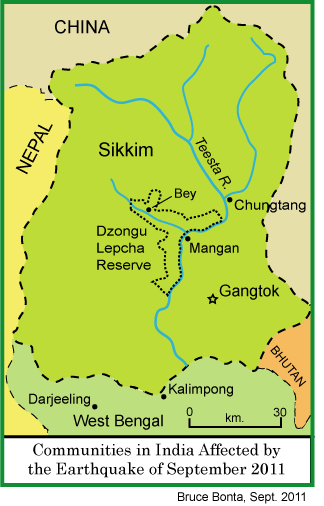Sangcho Lepcha, a resident of the village of Bey in northern Sikkim, was preparing momos, a type of Nepalese dumpling, when he felt the earth quaking. “I heard something that sounded like an explosion. The house started shaking and I rushed to get my child who was sleeping in the next room. By the time I got there, the house had collapsed,” he recalled, as he spoke about the nightmare on Sunday evening, September 18th. Five members of his family, and two other people in his village, were killed.
 Many other Lepchas, as well as others in Sikkim and surrounding areas, were killed and injured by the earthquake. It caused landslides, which cut the main north south road in Sikkim between Mangan and Chungthang. It also closed 42 other roads according to the government website on September 25th. As always when these tragedies occur in mountainous areas, initial news reports were sketchy because of the difficulty of getting access to remote villages.
Many other Lepchas, as well as others in Sikkim and surrounding areas, were killed and injured by the earthquake. It caused landslides, which cut the main north south road in Sikkim between Mangan and Chungthang. It also closed 42 other roads according to the government website on September 25th. As always when these tragedies occur in mountainous areas, initial news reports were sketchy because of the difficulty of getting access to remote villages.
The epicenter of the quake, which measured 6.9 on the Richter scale, was located near the border with Nepal in northern Sikkim, northwest of the state capital of Gangtok—in the heart of Lepcha territory. It was the most severe earthquake in Sikkim in 20 years. Tremors were felt widely in northern India, as far as the capital of Delhi, and in neighboring countries.
At first, rescue operations were hampered by rain as well as the landslides. Initial reports were that at least 26 people had been killed and that damages may amount to one lakh crore rupees (about 20 billion US dollars). Pawan Chamling, the Chief Minister of Sikkim, said at a news conference that he would be asking the national government in Delhi to assist the state in rescue and rebuilding operations.
Landslides blocked rescuers from reaching the remote villages of the Lepcha and Bhutia peoples. In one village, for instance, Tashi Lepcha and Sonam Lepcha were buried inside their Maruti 800, a Suzuki model car that is manufactured in India. In another village, many people were still buried as of Tuesday, according to local residents.
Army helicopters have been able to reach some areas and provide emergency assistance, but several regions are completely inaccessible. The Chungthang area of northern Sikkim is cut off, as is the Dzongu Lepcha Reserve. People were killed by the landslides plunging down mountains because there was no way they could avoid the falling rocks in the darkness.
The two major buildings of the Rumtek monastery, located about 24 km from Gangtok, were both heavily damaged. The Karma Shri Nalanda Institute, which is part of the monastery, has been forced to move its young monks outdoors, since the buildings are unsafe. One young monk told a reporter that even a mild earthquake would bring the buildings down on top of them.
By Thursday, authorities were estimating that it would take about three or four weeks before the road from Mangan to Chungthang could be reopened. Essential supplies will have to be airlifted into Chungthang by helicopter until then. Chungthang has an army base, so there are some stocks of essentials available in that town to help tide people over. The community is largely populated by Lepchas.
A politician from the Chungthang area, Mr. T. W. Lepcha, told a reporter that the state would be airlifting 300 quintals (30,000 kg.) of rice to help feed people until the road can be reopened. Mr. Lepcha said that many stretches of the highway had been eliminated by the earthquake, and at least 22 bodies had been recovered.
Nine Lepcha villages with at least 1,000 residents in the Dzongu Reserve remained cut off from outside rescue and relief workers. As of Thursday, the death toll had climbed to 74 in Sikkim, 15 in West Bengal state, plus nine others in India, seven in China, and one in Bhutan—117 in all.
The dead are not all Lepcha. Many are outside workers hired to construct one of the large hydropower dams being built in the Teesta river basin. The company involved with the construction project said the workers were not killed by the collapse of a tunnel, but by landslides caused by the earthquake.
Officials are quite worried about the survivors in the nine Dzongu Lepcha villages. K.S. Topgay, a spokesperson for the government of Sikkim, said that many homes were simply wiped away. Sikkim government personnel are penetrating into these villages on foot to help out, as are hundreds of members of the National Disaster Response Force.
In Bey, where Sangcho Lepcha lost five members of his family, other houses were also destroyed by falling boulders. Many people were injured. Sangcho Lepcha was knocked unconscious for a period of time but when he came to, he crawled into a nearby cave for the night. Then he and about 50 other villagers walked for seven hours to reach another village.
Another Bey villager, Aprilmit Lepcha, said of Sangcho that he is still in shock. “He does not even know that his family members have been cremated. He stays silent most of the time,” the man said.